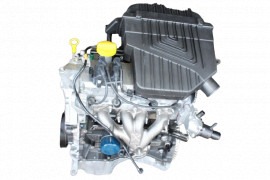Update Your Lorry with a New Opel Corsa Engine
Update Your Lorry with a New Opel Corsa Engine
Blog Article
Exploring the Inner Operation of a Compact Car's Engine System
As vehicle drivers, we commonly take for provided the complex processes that take place within the confines of our lorry's engine system. In this exploration of a portable vehicle's engine system, we will certainly decipher the internal operations of this mechanical symphony, dropping light on the mysteries that drive us forward on our day-to-day journeys.
Combustion Refine Overview
The combustion process in a compact automobile's engine system is an essential device that effectively transforms gas into power to power the car. This process takes place within the combustion chamber of the engine, where fuel and air mix, stir up, and generate controlled explosions. The combustion procedure consists of 4 primary phases: intake, power, exhaust, and compression.
Throughout the consumption stage, the piston relocates downward, attracting in a mix of air and fuel into the burning chamber. This descending movement produces the power needed to drive the lorry. This cyclic combustion process is essential to the procedure of a compact vehicle's engine system, making certain reliable power conversion for propulsion.
Piston and Cylinder Communication

The piston's precise fit within the cylinder is crucial for preserving optimal compression and avoiding energy loss throughout burning. Tight clearances between the piston and cyndrical tube wall surfaces make sure reliable sealing, allowing the piston to relocate smoothly without permitting gases to leak past. Proper lubrication is likewise vital to minimize friction and put on between these elements, enhancing long life and efficiency.
Moreover, the style and materials utilized in manufacturing the piston and cyndrical tube effect engine effectiveness and resilience. Modern engines commonly employ light-weight yet resilient products like aluminum alloys for pistons and cylinder linings to reduce inertia and enhance thermal effectiveness. In general, the harmonious communication between the piston and cylinder is fundamental to the engine's performance and general efficiency.
Fuel Shot System Performance
Gas shot systems in small car engines play a vital function in exactly supplying fuel to the combustion chamber for regulated and reliable ignition. The fuel shot system works by injecting fuel into the burning chamber at the optimal minute during the engine's procedure (opel corsa engine). This accurate timing ensures that the gas blends equally with the air for appropriate burning, causing boosted fuel performance and lowered emissions
There are primarily two sorts of gas shot systems made use of in portable automobile engines: port gas shot (PFI) and direct gas shot (DFI) PFI systems infuse fuel into the intake port prior to the consumption shutoff, while DFI systems infuse fuel directly into the combustion chamber. Both systems have their advantages, with DFI using better fuel atomization and PFI giving an extra economical option.
Recognizing Engine Air Conditioning Mechanisms
Efficient procedure of a compact car's engine relies greatly on the effectiveness of its cooling mechanisms. Engine cooling is vital to avoid getting site link too hot, which can lead to serious damages and reduced efficiency. The air conditioning system in a compact vehicle commonly consists of numerous parts interacting to control the engine temperature. One vital part is the radiator, which uses coolant to take in heat from the engine. As the hot coolant streams with the radiator, it releases warmth right into the air, cooling off before going back to the engine. The water pump circulates the coolant with the engine and radiator, making sure a constant flow to manage temperature level. Additionally, the thermostat aids manage the coolant circulation to maintain optimal engine temperature level. Some cars also have cooling fans that trigger when additional air conditioning is required, such as during hefty traffic or hot climate. Recognizing these engine air conditioning devices is important for keeping the performance and longevity of a small car's engine system.

Exhaust System Elements Explained
The optimum functioning of a small lorry's engine cooling mechanisms depends upon a complementary system known as the exhaust system, which makes up numerous necessary components for ensuring effective discharges and engine performance. The exhaust system consists of components such as the exhaust manifold, catalytic converter, muffler, and tailpipe. The exhaust manifold collects exhaust gases from the engine's directory cylinders and paths them to the catalytic converter. The catalytic converter then transforms damaging contaminants in the exhaust right into less hazardous exhausts prior to releasing them through the muffler and tailpipe.
One critical part of the exhaust system is the oxygen sensing unit, which checks the oxygen degrees in the exhaust gases to aid manage fuel intake and ensure optimal engine performance. opel corsa engine. Furthermore, the resonator might exist in some exhaust systems to decrease sound degrees. Overall, the exhaust system plays an essential role in maintaining engine effectiveness, decreasing unsafe emissions, and guaranteeing a quieter driving experience Bonuses for compact vehicle owners

Conclusion
To conclude, the portable vehicle's engine system is a complicated combination of elements that interact to promote the combustion procedure, transform gas into energy, and eliminate waste gases. Comprehending the inner functions of the engine system, including the piston and cyndrical tube communication, fuel shot system, engine air conditioning mechanisms, and exhaust system parts, is crucial for preserving ideal efficiency and performance of the vehicle.
The combustion procedure in a compact automobile's engine system is a crucial system that efficiently converts fuel into energy to power the vehicle.Fuel shot systems in portable vehicle engines play a crucial function in specifically supplying fuel to the combustion chamber for reliable and regulated ignition.There are mainly 2 kinds of gas shot systems used in small lorry engines: port gas shot (PFI) and direct fuel injection (DFI) Understanding these engine cooling mechanisms is crucial for keeping the efficiency and longevity of a portable car's engine system.
The ideal functioning of a compact vehicle's engine cooling mechanisms depends on a complementary system understood as the exhaust system, which consists of numerous essential parts for making certain reliable exhausts and engine performance.
Report this page